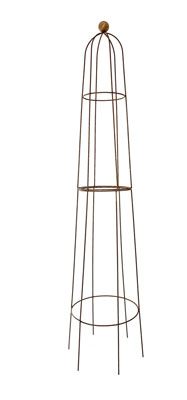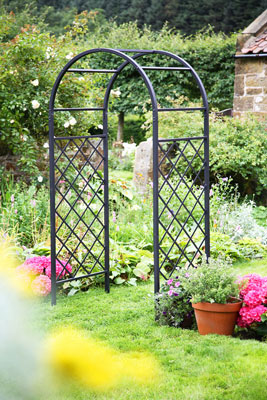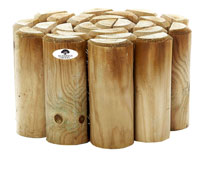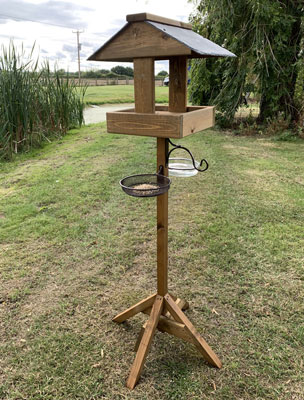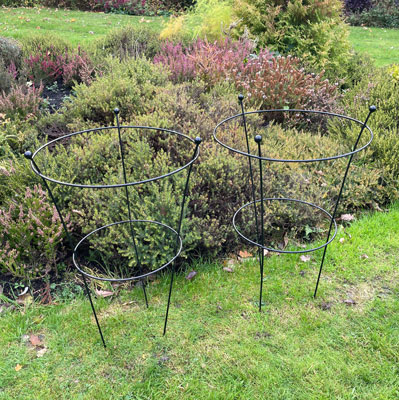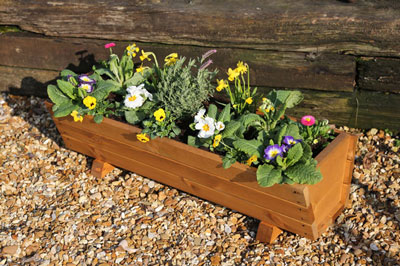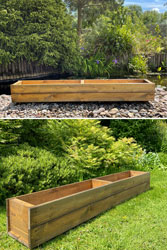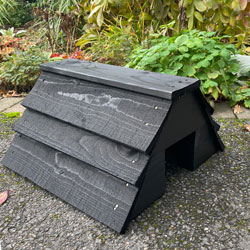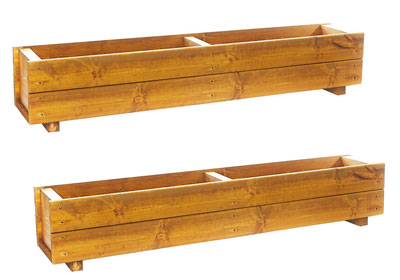Gardens to Visit
Garden Break
Our Christmas present to each other was a city break in southern Europe, to try for a little sun and warmth instead of the January grey. We went last Monday, and returned on Friday. It was lovely to be able to wander about in temperatures of about 15o C, with gentle sun and so many flowering plants. Some flowers were obviously last summer’s blooms, such as the strelitzia, or Bird of Paradise plants, which were somewhat ragged around the edges, but there were many which we would expect to see in April or May.
In one of the larger parks, there is a cool greenhouse, with half walls and roof of wooden slats, keeping the extremes of cold, wet and sun from spoiling the plants. Constructed on the site of a former quarry, which ceased production when a stream became too much of a problem, it makes excellent use of the features which remain. The stream runs on various levels, flowing between close-set stepping stones, creating ponds and cascades and generally keeping the humidity fairly high, encouraging the vigorous growth of many ferns, including several tree ferns from Australasia. The side walls are only half height, so birds dart in and out, and one tiny wren was so fearless it flew between us, settling only a few feet from us to feed. Natural air movement causes leaves to sway to and fro; the overall ambience is very restful.
Several squares and avenues lined with blue-flowered Jacaranda trees will be spectacular later in the year. Also popular is the Indian Bean Tree (Catalpa Bignoides) with its foot long bean pods. Spring will see large clusters of creamy white flowers, followed by a heavy harvest of broad-bean-like pods.
Pay back time came when we returned to snow covered hills and a brief blizzard on our journey home, batteries re-charged.
Gardens to Visit - Bodnant
Bodnant has been the home of the Aberconway family since 1875 when the estate was bought by Henry Pochin a retired industrial chemist, who was the great grandfather of the present Lord Aberconway. It is to be found 7 miles south of Llandudno and Colwyn Bay in North Wales.
The garden is in two parts, the upper part around the house is terraced and has shady lawns; the lower part, known as the Dell is part of the valley of the River Hiraethlyn.
There are perhaps two reasons above all others why you should visit this garden, the Laburnum arch and the Pin Mill, both of which are, quite rightly, world famous.
The Laburnum arch is at the edge of the East Garden, close to the road; it is a curved walk beneath pleached laburnums supported on a metal framework. In late May and early June this will be as dramatic a sight as you have ever seen in a garden, as the long racemes of yellow flowers provide a complete canopy above you.
The Pin Mill was moved to the Garden from Gloucestershire in the very late 1930's, having originally been a summer house, the a mill for the manufacture of pins, and lastly a tanner's store. It was re-erected in the garden at the end of the Canal Terrace, so that it is reflected in the water. It was rescued from dereliction because it was such a beautiful building, and now in its stunning site in the gardens forms every bit as good an example of how garden and architecture can complement each other as anything at Stourhead.
The garden is an excellent place to see a vast array of shrubs to help you decide which you would like in your own garden. Rhododendrons and camellias are numerous and would again suggest a late May visit, but there is always much to see, whatever the time of year. The very common winter flowering add perfumed Viburnum Bodnantense was bred here.
Unless you really have problems walking do follow the path right around the Dell from the waterfall to the Old Mill, the astilbes and the shrubs make a stunning display.
Visit to Gardens
Biddulph Grange is a National Trust Garden in the village of Biddulph between Congleton and Leek in Staffordshire. It was created by James Bateman in the mid 19th Century to house his collection of plants from all around the world. The house itself has had a very chequered history, having been destroyed by fire, used as various types of hospital and finally developed into the apartments it is today. The National Trust acquired the gardens in 1988 and the majority of the restoration work was carried out over the next three years.
The glory of this garden is as much in the originality of many of its areas as in its overall design and the ways in which the rooms are separated. It is probably the only truly exciting garden to explore with its tunnels and ravine and its amazing Temple of Thoth.
For me the best bit is to walk up the Glen towards the Chinese Garden, you then go through a tunnel and emerge into a Chinese pavilion with the most stunning view of the Chinese Garden. A real WOW factor!
Egypt is another very individual area with lots of interest including the aforementioned Thoth who was a servant to the Egyptian god of botany.
The rhododendron area is very attractive in its season, and the nearby upside down tree (yes, roots in the air!) quite stunning. In a similar vein the stumpery is by far the most dramatic I have seen.
Apart from all this drama and fun there are more conventional and very beautiful gardens, perhaps foremost amongst these the dahlia walk and the woodland areas. Truly a varied and brilliant garden and one that any children will love because of its tunnels and surprises and novelty.
Really not one to be missed.
Stourhead Gardens
Stourhead is situated in the south western tip of Wiltshire, not surprisingly at the top of the Stour valley.
The gardens were started by Henry Hoare who moved to Stourhead from his Hampshire estate in 1742. He was already a rich man by his mid thirties from the family banking interests. The estate at Stourhead was attractive with its pond and river and pleasant contours and Henry set about to improve on this promising starting point.
His first job was to plant a large shelter belt of trees to reduce the effects of the cold winter winds. He then employed the architect, Henry Flitcroft, to design a number of buildings of classical (Greek) style with a mythological theme. These were placed on the far bank of the river so that glimpses of them were to be had as he walked his guests down what is now the Fir Walk.
He then saw that the effect would be immensely improved if there were more water – so the valley was dammed, and thus the modern day lake was created. Initially a rickety bridge gave access to the grotto which contains wonderful statues of a River God and a Nymph, but later this was replaced by a ferry. The main buildings are the Temple of Flora, the Temple of Apollo and the Pantheon. The Bristol High Cross is a relatively recent addition when that structure was removed from its original site in Bristol.
Subsequent generations of Henry Hoare’s family have looked to the planting of the parkland with what were at the time exotic trees and shrubs, particularly rhododendrons and many deciduous trees including the famous tulip tree on the island.
It is the beauty of the architecture and how well these buildings have been sited in the contours of the land together with the inspired planting that make this garden world famous. The paths that you take are rarely straight, so there is always the desire to see what is round the next corner, and occasionally you are rewarded by a stunning view of a beautiful building across the water. A truly fabulous bit of garden design, with scarcely a flower to be seen!
Garden to Visit to Heligan
Situated not far from St.Austell in Cornwall, Heligan has become one of the most famous gardens in the UK over the last two decades; there can be very few readers who do not know something of its rescue and redevelopment.
The garden’s history can be traced back to the early 1600’s when the Tremayne family built the original house, but it’s modern history starts after the two World Wars when a lot of the estate workers had died in the service of their country and the maintenance became no longer viable. Things got worse and in 1970 the Tremaynes sold the house. Jump now to 1990 when Tim Smit and John Willis (a descendant of the Tremaynes) explored the gardens which were by now totally overgrown and derelict. They decided to act and the restoration project was born. It took two years hard work before the first areas could be opened to the public and revenue could start to flow.
So why should you visit? For a start it has been, and still is, a magnificent project and deserves support from all of us, but more that this it shows, better than most gardens, how life would have been for both the family and the estate workers (to whom the garden is dedicated) in the 19th and early 20th Centuries. The vegetable garden and melon yard is especially full of historical and horticultural interest.
There are also many other areas and features which will give visitors good reason to enjoy their time here. Near the beginning of your visit you will find Flora’s Green (named after the Roman Goddess), where between January and May you will find some magnificent large rhododendrons in flower. It is a lovely place to sit a while on one of the many wheeled seats provided and take in the beauty. Those with technical interest should not miss the nearby reservoir and ram pump which were, and are again, responsible for irrigating the gardens via a series of dipping pools.
When in the area of the melon yard do not miss the bee boles the forerunners of modern hives.
Nearby the flower garden and its associated building and greenhouses have much of interest to show. There are areas devoted to the plants of New Zealand and Sikkim (northern India).
Beyond this there are much less manicured areas to explore, the jungle, the lost valley complete with charcoal burning and a series of lakes/ponds. One can walk much further through fields and those interested in the birdlife can spend time at the Horsemoor Hide.
You should allow a full day for your visit, which I am sure you will find worthwhile.


